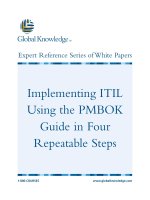Implementing ITIL Using the PMBOK Guide in Four Repeatable Steps
Bạn đang xem bản rút gọn của tài liệu. Xem và tải ngay bản đầy đủ của tài liệu tại đây (176.1 KB, 10 trang )
Implementing ITIL
Using the PMBOK
Guide in Four
Repeatable Steps
1-800-COURSES
www.globalknowledge.com
Expert Reference Series of White Papers
Introduction
`Begin at the beginning,' the King said gravely, `and go on till you come to the end: then stop.'
–Alice in Wonderland, Lewis Carroll
1
So exactly where is the beginning and where is the end of an IT Service Management (ITSM) project? There
may be many beginnings and many ends in implementing ITSM—depending on your approach. Implementing
ITSM in any organization can be a daunting task at first glance
. But once you understand that it can be done
as a series of projects rather than just one big one, and when you combine the application of sound project
management techniques, as defined in
A Guide Project Management Body of Knowledge
(PMBOK
®
Guide)
from the Project Management Institute (PMI), with the power of the best practices for the k
ey process areas
and functions within the IT Infrastructure Library™ (ITIL), it will seem far less daunting.
This white paper starts by providing the reader with an overview of the PMBOK
®
Guide as well as the key
process areas and functions within the IT Infrastructure Library. We then compare and contrast the two bodies
of knowledge. Once we have set the foundation for discussion, we look at why many IT projects fail (not just
ITSM ones), followed by delivery risk management. Using that construct, we provide the reader with a project
roadmap to implementing IT Service Management based on ITIL. We conclude with what is required to support
ITSM once implemented, including how project management has not only a role in continued ITSM success but
is a necessary ingredient—when used in the right situations.
This white paper does not attempt to teach you either project management or ITIL, but rather to describe by
example how implementing the ITIL framework can best be accomplished when done under the control of
good project management practice
.
PMBOK
®
Guide
While there are numerous project management methodologies around the world, the quintessential project
management methodology in the North American marketplace is the PMBOK
®
Guide from the Project
Management Institute
.
Project management, in a general sense, is the discipline of defining and achieving targets while managing
and optimizing the use of resources (time, money, people, materials, energy, space, etc). The utilization of proj-
ect management practices has become essential for a business to deliver value and services. The PMBOK
®
Guide defines project management as “the application of knowledge, skills, tools, and techniques to project
activities in order to meet or exceed stakeholder needs and expectations.” The emphasis is on projects as a
“temporary endeavor undertaken to create a unique product or service.”
Lawrence Cooper, PMP, CPM, ITIL Service Manager
Implementing ITIL
®
using the PMBOK
®
Guide in Four Repeatable Steps
Copyright ©2006 Global Knowledge T
raining LLC. All rights reserved. PMI and PMBOK are registered trademarks
of the Project Management Institute, Inc. ITIL is a Registered Trade Mark, and a Registered Community Trade
Mark of the Office of Government Commerce, and is registered in the U.S. Patent and Trademark Office.
Page 2
W
ithin the PMBOK
®
G
uide there are nine knowledge areas and 44 processes (see Figure 1: PMBOK
®
G
uide
Knowledge and Process Areas). These knowledge areas provide a set of best practices in Project Management
that are industry and project agnostic. The PMBOK
®
Project Management processes are further divided into
five process groups:
• Initiating
• Planning
• Executing
• Monitoring and Controlling
• Closing
Figure 1: PMBOK
®
Guide Knowledge and Process Areas
Copyright ©2006 Global Knowledge T
raining LLC. All rights reserved.
Page 3
Project Management
Body of Knowledge
4 Project Integration Management
4
.1 Develop Project Charter
4.2 Develop Preliminary Project Scope
Statement
4.3 Develop Project Management Plan
4.4 Direct & Manage Project Execution
4.5 Monitor & Control Project Work
4.6 Integrated Change Control
4.7 Close Project
5 Project Scope Management
5.1 Scope Planning
5.2 Scope Definition
5.3 Create WBS
5.4 Scope Verification
5.5 Scope Control
6
Project Time Management
6.1 Activity Definition
6.2 Activity Sequencing
6.3 Activity Resource Estimating
6.4 Activity Duration Estimating
6.5 Schedule Development
6.6 Schedule Control
9 Project Human Resource
Management
9.1 Human Resource Planning
9.2 Acquire Project Team
9.3 Develop Project Team
9.4 Manage Project Team
12 Project Procurement
Management
12.1 Plan Purchases & Acquisitions
12.2 Plan Contracting
12.3 Request Sellers Response
12.4 Select Sellers
12.5 Contract Administration
12.6 Contract Closure
11 Project Risk Management
11.1 Risk Management Planning
11.2 Risk Identification
11.3 Qualitative Risk Analysis
11.4 Quantitative Risk Analysis
11.5 Risk Response Planning
11.6 Risk Monitoring and Control
7 Project Cost Management
7.1 Cost Estimating
7.2 Cost Budgeting
7.3 Cost Control
10 Project Communications
Management
10.1 Communications Planning
10.2 Information Distribution
10.3 Performance Reporting
10.4 Manage Stakeholders
8 Project Quality Management
8.1 Quality Planning
8.2 Perform Quality Assurance
8.3 Perform Quality Control
A
s noted, each PMBOK
®
G
uide knowledge area includes several processes, each of which is designed to pro-
vide guidance on how to apply it to a real project. For example, Project Scope Management (5 in Figure 1) pro-
vides guidance on how to define the scope of your project, how to translate that scope into identified deliver-
ables, how to define the work needed to create those deliverables (the Work Breakdown Structure), and how
to verify that your scope is being met (neither under nor over scope) through scope control and verification.
IT Infrastructure Library (ITIL)
The Information Technology Infrastructure Library (ITIL) is a framework of best practices for quality IT Service
Management; IT Service Management is defined as the delivery and support of IT services to meet the busi-
ness needs of an organization. These procedures are vendor-independent and apply to all aspects of IT infra-
structure. ITIL is made up of a collection of books that describe the different aspects of IT Service
Management. The Service Support and Service Delivery manuals are viewed as the core of ITIL, which is built
on a process-model view of controlling and managing operations.
The recommendations of ITIL were developed in the late 1980s by the United Kingdom Central Computer and
T
elecommunications Agency (CCTA), which later merged into the Office of Government Commerce (OGC). ITIL
has been readily adopted and accepted as a global standard for IT Service Management since the mid-1990s.
Figure 2: The ITIL Framework
T
he subjects of the individual books are referred to as sets
.
T
he sets are further divided into disciplines, each of
which focuses on a specific subject. The ITIL sets and their disciplines are:
1. Service Support—stabilization of services:
• Service Desk
• Incident Management
• Problem Management
• Configuration Management
Copyright ©2006 Global Knowledge T
raining LLC. All rights reserved.
Page 4
The Business The Technology
The Business
Perspective
ICT Infrastructure
Management
Planning to Implement Service Management
Applications Management
Service Management
Service Support
Service Delivery .
Security
Management
•
Change Management
• Release Management
2. Service Delivery—services that must be provided to the business:
• Service Level Management
• Availability Management
• Capacity Management
• IT Service Continuity Management
• IT Financial Management
3. Planning to Implement Service Management—how to adopt ITIL; how an organization could benefit
from ITIL and how to reap such benefits.
4. Security Management—how to manage security
5. ICT Infrastructure Management—processes, organization, and tools that are needed to provide a sta-
ble IT and communications infrastructure:
• Network Service Management
• Operations Management
• Management of local processors
• Computer installation and acceptance
• Systems Management
6.
The Business Per
spective
—how IT services relate to the requirements and operation of a business
.
7. Application Management—how to manage the software development life cycle.
8. Software Asset Management—how to manage software assets
Project Management and ITIL – A BoK Comparison
The table below provides a side-by-side comparison of the Project Management and ITIL Bodies of Knowledge
(BoK). As can be seen, they are similar in age (20+ years) and rely on the active involvement of practitioners to
update them to reflect current best practice. They also share remarkably similar objectives. The key differentia-
tors between them are that project management can be applied to any domain, whereas ITIL has application
only within the IT domain. Also, the PMBOK
®
Guide contains a code of ethics for professional conduct that can
result in suspension or loss of accreditation for ethical breeches, whereas ITIL does not.
While the PMBOK
®
Guide certainly has a wider sphere of influence and the Project Management Professional
(PMP
®
) is a very widely recognized certification in the IT industry and elsewhere, the past several years have
witnessed a strong surge in ITIL awareness and interest within the IT community.
IT Project Failures
Anyone who has ever worked on a very large IT project likely has experiences with massive project failure.
Some of the more common causes are listed below:
• Project timelines beyond 6–12 months generally result in a project going over budget and failure to
deliver on the promised benefits—detailed project planning is hard to do beyond 6 months
• Failed projects usually suffer from a lack of focus and momentum after about the 5-6 month mark
• Poorly defined scope (and requirements) and scope creep because of unclear goals objectives
• No change control system to handle scope changes
• Lack of executive commitment and user interest due to the long timelines involved
• F
ailure to communicate and act as a team
• The wrong skills or not enough of the right skills
Copyright ©2006 Global Knowledge T
raining LLC. All rights reserved.
Page 5









